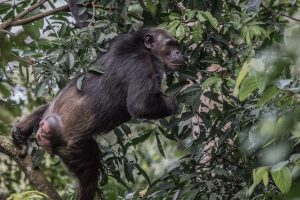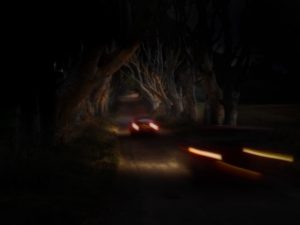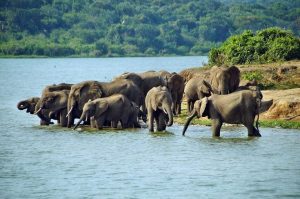Mountain gorilla families in Uganda
Initially, they faced threats from habitat loss, poaching, and human wildlife conflict, but in the 1990s, Uganda implemented gorilla trekking tourism, turning gorillas into a valuable asset and significantly boosting conservation. This, coupled with community involvement, has led to a gradual increase in their population. Mountain gorilla families in Uganda
Mountain gorillas’ history in Uganda
Early threats
Mountain gorillas became critically endangered in the early to mid-20th century due to habitat loss caused by logging, agriculture, and poaching.
Conservation milestones
Bwindi was classified as a forest reserve in 1961 before becoming Bwindi Impenetrable National Park in 1991, which was a key step toward protecting the ecology.
Habituation and research
The process of gorilla habituation, making them accustomed to human presence, began in the 1990s in Bwindi..Research,h, including studies by Carlakeley and George Schaller, also played a vital role in understanding and protecting them.
Gorilla trekking tourism
The introduction of gorilla trekking tourism in the mid-1990s was a pivotal movementtransforming gorillas from targets into the source of revenue and conservation funding.
Community involvement
Uganda’s successful conservation model emphasizes community participationensuring that the local communities benefit from gorilla tourism and actively participate in conservation efforts.
Current status
Uganda has 19 habituated gorilla families with treks available in Bwindi Impenetrable National Park and Mgahinga National Park.
Different mountain gorilla families in Uganda
Uganda has numerous habituated mountain gorillas suitable for trekking. These include the Mubae, Habinyana, Rushegua, Bitukur, Oruzogo, NkuringoNshongi, Mishaya Kahungy, Bweza, and Busigyee families.
Buhoma area
Mubare, H. Abinyanj, a, and Rushegura families
Ruhija area
Bitukura and oruzogo families
Nkuringo area
Nkuringo family
Rushaga area
Nshogi, Mishaya, Kahungy, Bwez, and Busigye families
Mgahinga Gorilla National Park
Nyakagezi family
Some information about mountain gorillas
- Gorillas are led by a dominant silverback
- Habituation of a gorilla family for trekking can take 2-3 years
- Trekking is a popular activity that allows tourists to observe gorillas in their natural habitats
- The Nshongi family was the most frequent in Bwindi.
The kyaguriro family is utilized for study and is not exposed to tourists. - Some information about habituated mountain gorillas in Bwindi
Mubare gorilla family
This is the oldest habituated gorilla family in Bwindi, with nine members. The family is led by Maraya, a formidable silverback.
Habinyanja gorilla family
This gorilla family lives in the Nyamishamba area.The family name derives from the Rukiga term Nyanja, which refers to the tribe’s former home. This group was first spotted near a marsh in the Bwindi Impenetrable National Park.
Rushegura gorilla family
It has 19 members and was named by primate scientists after Ebishegurathis, one of the 12 habituated gorilla groups discovered in the Buhoma section of Bwindi Impenetrable National Park. It is one of the park’s most well-known bigger groups, known for its tranquil, easygoing nature and named for a local tree species.
Bitukura gorilla family.
It has 14 members and is unique in that mature men tolerate each other pretty well. It is the most recent habituated group in Bwindi Impenetrable National Park. The group was first sighted along the river in 2007, with a total of 24 members.
Oruzogo gorilla family
Has ten members and is found in the Ruhija area, led by a dominating silverback named Bakwate. It is one of the park’s most recent gorilla families to be made accessible to visitors. It began receiving visitors in 2011, and those who have been to see them adore them.
nkurigo gorilla family
A local family, meaning a round hill. Iis a word from the Rukiga language. It is the newest gorilla family in Rusgagasector. It was born out of a wrangle by opening for visitors, the community could easily benefit from tourism, and formed a protection for gorillas as well..
Nshongi gorilla family
The family was established in 20 with much pomp. It presently has more than 25 mountain gorillas and is led by a powerful silverback.
Posho gorilla family
It resides in the Nkurigo sector of Bwindi Impenetrable National Park. The family named after its founding silverback is relatively new and is currently undergoing habituation. Once the situation is complete, it will be open for gorilla trekking experiences. The family currently consists of 1 4, including Silverbackerback Magarawho leads and protects thgroupup
Background
Posh formed the family after breaking away from the Nkuringo dynasty.
Trekking
Once habituation is complete, the posh group will be open for tracking, allowing visitors to observe them in their natural habitat
Muyambi gorilla family
Muyambi, a silverback, leads a troop of 6-8 individuals in the Buhoma section of Bwindi Impenetrable National Park. was a member of the Mubare gorilla family before founding his group. The family is well-known for its playful youngsters and active behavior, making it a favorite gorilla trekking destination.
Trekking
The family was opened for tourism in 2020
Characteristics
- An active offering of an engaging trekking experience
What is re gorilla family in Mgahinga National Park?
It is the home of the habituated gorilla family, the Nyakagezi group. This family is notorious for its irregular migrations, occasionally wandering into neighboring Rwanda and the Democratic Republic of Congo. This gorilla family is led by a dominant silverback and typically consists of around 10 members, including other silverbacks, adult females, juveniles infants
Best time to go for gorilla trekking in uganda
is during june to september and december to february .these periods offer the most comfortable hiking conditions with less rain and mud making it easier to navigate the trails and spot the gorillas .
.




